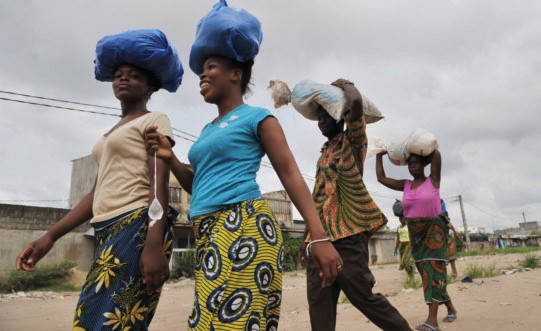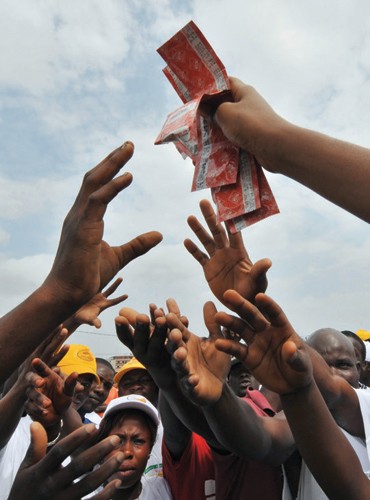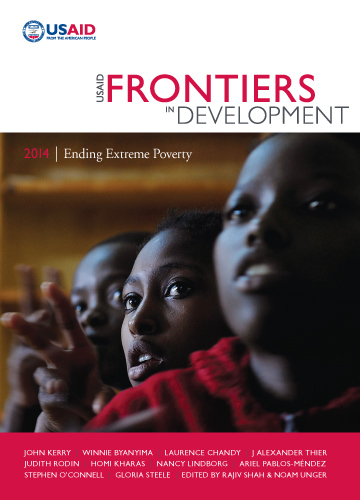Andrea Halverson
Around the table, each woman raised her hand when asked if she was a mother. Most women spoke of five or six children; one was a mother of 11—numbers not unusual for the area. We were in western Côte d’Ivoire, visiting a USAID-funded community program for HIV-affected households. We had met the women who had been keeping their communities intact during political upheaval and economic uncertainty by caring for children orphaned by HIV and AIDS in addition to their own.
In western Côte d’Ivoire, each woman will give birth six times on average. The national average is five births per woman.1 At the same time, 27 percent of women in Côte d’Ivoire would like to delay or avoid pregnancy but are not using any family planning method.2

This unmet need, coupled with post-conflict political fragility, weak institutions and overall economic insecurity, creates a challenging environment for ending extreme poverty by 2030 in Côte d’Ivoire and throughout sub-Saharan Africa. Family planning programs as part of a robust system of maternal and child health care are essential to achieving this goal.
Setting the stage: family planning in the context of economic fragility
Like most African countries, Côte d’Ivoire has not realized the progress toward contraceptive prevalence and fertility reduction that has been seen throughout the world since 1990. In all other parts of the world, fertility rates have declined to fewer than three births per woman.3
Africa remains the exception, with a continental average of 4.7 births per woman and regional rates of up to 6.3 in Central Africa and 5.7 in Western Africa.4 Contraceptive prevalence throughout sub-Saharan Africa remains below 20 percent. Furthermore, in Côte d’Ivoire, only 18 percent of married women use any form of family planning.5 Use of contraception in other conflict-affected states is similarly low.
In part due to a decade of conflict, Côte d’Ivoire also does not share in global and regional poverty reduction trends. Between 1990 and 2012, the percentage of persons living on less than $1.25 per day in sub-Saharan Africa declined from 56 to 48 percent.6 Over a similar timeframe in Côte d’Ivoire, the poverty rate for people living on less than $1.41 per day increased from 33.6 percent to 48.9 percent,7 an alarming spike for a country that was previously seen as an engine of regional economic growth. According to a World Bank analysis, the number of extreme poor living in Côte d’Ivoire is projected to increase from 4.3 million in 2010 to 10.3 million in 2030 if current trajectories continue.8
Equitably achieving and sustaining poverty- reduction goals here and in other fragile, conflict-affected states will require inclusive, sustained development, partnership and investments in voluntary family planning programs. Without these efforts, Africa’s high fertility rates will translate to a growing global share of inequality, and sub-Saharan Africans will continue to represent a disproportionate absolute number of the percentage living in extreme poverty.
The complexities and benefits of gender-sensitive family planning programming
Demographics need not be destiny. Extreme poverty can be eradicated. However, doing so requires understanding the complex relationship between family planning, gender equality and economic growth.
Access to contraception is critical to women’s self-determination and empowerment and has mutually reinforcing benefits for women and society. Women who have fewer children have more opportunities to become wage earners, boosting family income levels.9 As women gain access to productive resources, they also report better health outcomes, achieve higher levels of education and experience a lower incidence of intimate partner violence.10
These same positive effects are also true for their children.11 Adolescent girls who delay pregnancy tend to complete more years of schooling, and women with more years of school tend to have fewer children.12 Investments in family planning thus create a reinforcing cycle of empowerment, supporting healthy, educated and economically productive women and families.
Family planning is also an extremely cost-effective intervention. For every dollar invested in family planning, up to six dollars are saved in future health, education, immunization and maternal health costs that instead can be invested in public spending for stable communities.13 With effective family planning, governments can make targeted social investments without the added pressure of exponential population growth and its concomitant needs. Meeting the family planning needs of HIV-positive women is especially critical in sub-Saharan Africa and delivers a return on investment by eliminating the costs of prevention of mother-to-child transmission programs and future HIV treatments for children who are born HIV-positive.
In addition, investments in family planning could generate a demographic dividend. When the size of the dependent population (i.e., children and the elderly) shrinks relative to the size of the working-age population, it creates an economic advantage—especially in countries that lag economically. If developing countries with high birth rates like Côte d’Ivoire reduce fertility, the combination of increased wage earners and decreased dependency will fuel major economic growth.14
However, the fragility of Côte d’Ivoire and other states vulnerable to conflict and corruption creates myriad programmatic challenges for health and family planning services, including a lack of trained medical personnel and a low number of available, stocked service centers.15 Furthermore, threats of conflict can deter health-seeking behavior when women do not feel safe traveling to health clinics and therefore fail to receive care. The security situation in Côte d’Ivoire continues to stabilize, providing hope for synergy between political reconciliation and stronger health systems. Yet here and in other fragile states, weak institutions make family planning particularly challenging.
USAID’s investments in voluntary family planning programs
Although investments in international family planning programs have lagged since the mid-1990s, recent international movements have re-galvanized attention and resources, especially to address unmet family planning needs in sub-Saharan Africa.
USAID is playing a key leadership role in scaling up informed, voluntary, evidence-based family planning approaches throughout the region. USAID’s record of success includes two decades of focus in Asia and Latin America. In these two regions, 24 countries have graduated from family planning assistance by demonstrating their governments’ abilities to maintain progress toward key family planning indicators.16
Much of the work that remains now resides in sub-Saharan Africa, home to 16 of USAID’s 24 current family planning focus countries.17 USAID has tripled its monetary investments here,18 and many of the countries are already achieving important gains, including increases in contraceptive prevalence rates from 2004-2011 in seven countries identified as USAID family planning priorities.
Success stories include Rwanda, where family planning use increased from 10 percent to 45 percent and total fertility reduced from 5.54 to 5.34 Malawi saw gains from 28 percent to 42 percent and a fractional decrease in fertility from 6.00 to 5.98. In Ethiopia, contraceptive use increased from 14 percent to 29 percent and total fertility decreased from 5.09 average births per woman to 4.04.
Reductions in total fertility tend to lag behind gains in contraceptive prevalence; thus, while these countries have seen moderate reductions in birth rates (as have most countries in Sub-Saharan Africa since 2000), future surveys will likely measure additional decreases in birth rates as a successful follow-on effect of these recent increases in contraceptive prevalence.19
USAID’s family planning programs focus on contraceptive access and method choice; they use community health workers to reach women in their communities—a strategy especially key in fragile contexts where women face barriers to reaching health facilities. USAID includes long-acting and permanent methods in the mix of options and has successfully negotiated unit cost reductions for its most in-demand injectable methods and implants.20

Programmatic success depends upon integrating family planning into existing maternal and child health service settings, especially HIV-positive mothers who wish to delay or avoid pregnancy. To that end, USAID has supported groundbreaking innovation and research on new commodities that protect women against both pregnancy and HIV acquisition. Several new dual-protection methods are on the horizon, including a long-lasting, anti-retroviral contraceptive ring that protects against HIV, herpes and pregnancy.21 This method is now undergoing clinical trials.
Family planning: the essential investment
Côte d’Ivoire is a country at a crossroads. As one of seven fragile states unlikely to achieve its Millennium Development Goals, it represents the final leg of extreme poverty reduction as 2030 approaches.22 At the same time, political transition and economic growth have created a window of opportunity conducive to a demographic dividend and the resulting economic and social advantages.
USAID’s efforts to reduce extreme poverty here and throughout Africa must account for the various factors that contribute to social and political vulnerability, especially weak maternal and child health care. They also must invest in the voluntary family planning programs that empower women as decisionmakers in their households and communities, programs that will be key to eradicating extreme poverty in Côte d’Ivoire and around the world.
Andrea Halverson serves as the deputy director of USAID’s Health Office in Côte d’Ivoire. The views expressed in this essay are her own and do not necessarily represent the views of the United States Agency for International Development or the United States Government.
1 Côte d’Ivoire Demographic and Health Survey (DHS) (2011-2012). MEASURE DHS, ICF International, Maryland, USA. June 2013.
2 Ibid.
3 Population Reference Bureau (PRB). (2013) “2013 World Population Data Sheet.” www.prb.org. Funded by USAID.
4 Ibid.
5 Côte d’Ivoire DHS (2011-2012).
6 Chandy L., et. al. (2013) “Africa’s Challenge to End Extreme Poverty by 2030: Too Slow or Too Far Behind?” The Brookings Institution. www.brookings.edu.
7 Fonds monétaire international. (2009) “Côte d’ Ivoire: Stratégie de Réduction de la Pauvreté Rapport 2009.” The IMF report uses the measure of 661 CFCA per day, which is the equivalent of $1.41 in US dollars at the 2009 exchange rate.
8 Yoshida, Nobuo and Uematsu, Hiroki and Sobrado, Carlos E., “Is Extreme Poverty Going to End? An Analytical Framework to Evaluate Progress in Ending Extreme Poverty” (January 1, 2014). World Bank Policy Research Working Paper No. 6740. Available at SSRN: http://ssrn.com/abstract=2375459
9 Bongaarts, John and Sinding, Steve. (2011) “Family Planning as an Economic Investment.” SAIS Review of International Affairs. Vol. 31. 10 Head, Sarah. et. al. (2014). “Women’s Lives and Challenges: Equality and Empowerment since 2000.” ICF International. Funded by USAID.
11 Ibid.
12 World Health Organization (2012). “Adolescent Pregnancy Fact Sheet.” http://www.who.int/mediacentre/factsheets/fs364/en/
13 United Nations, Department of Economic and Social Affairs, “What would it take to accelerate fertility decline in the least developed countries?” UN Population Division Policy Brief No. 2009/1.
14 Bongaarts, John and Sinding, Steve. (2011) “Family Planning as an Economic Investment.” SAIS Review of International Affairs. Vol. 31.
15 McGinn, et. al. “Family planning in conflict: results of cross-sectional baseline surveys in three African countries.” Conflict and Health 2011, 5:11.
16 USAID. (April 2013) Family Planning Program Overview. http://www.usaid.gov/sites/default/files/documents/1864/fp_overview.pdf
17 Kaiser Family Foundation. “USAID Family Planning Program Countries.” FY2011. Available online: http://kff.org/global-indicator/usaid-family-planning-program-countries/. Full list: Zambia, Uganda, Tanzania, South Sudan, Mozambique, Nigeria, Ghana, Mali, Malawi, Kenya, Liberia, Senegal, Rwanda, Madagascar, Ethiopia, Democratic Republic of the Congo, Yemen, Haiti, Nepal, Afghanistan, Bangladesh, India, Philippines, Pakistan.
18 USAID. (April 2013) Family Planning Program Overview.
19 Sharan, et. al. “Family Planning Trends in Sub-Saharan Africa: Progress, Prospects, and Lessons Learned.” Yes Africa Can. Success Stories from a Dynamic Continent (2011) World Bank Publication.
20 USAID. (April 2013) Family Planning Program Overview. http://www.usaid.gov/sites/default/files/documents/1864/fp_overview.pdf
21 Fellman, Megan. (March 5, 2014) “Long-lasting device protects against HIV and pregnancy.” Northwestern University. http://www.northwestern.edu/newscenter/stories/2014/03/long-lasting-devi...
22 USAID (2014) “Ending extreme poverty in fragile contexts: Getting to Zero: A USAID discussion series.”
Frontiers in Development
Section 4: Going Forward (Without Going Backward)








Comment
Make a general inquiry or suggest an improvement.